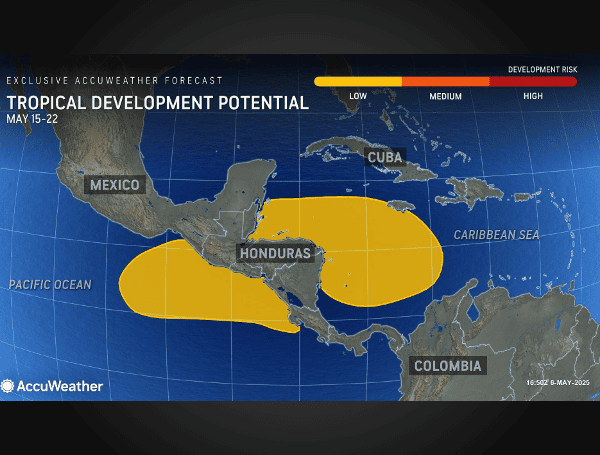As coastal communities across the Gulf Coast and eastern United States observe National Hurricane Preparedness Week, AccuWeather hurricane experts are alerting residents to the first potential risk of tropical development in the Atlantic basin this year, with a low risk identified for the Caribbean starting as early as next week.
According to a media advisory issued by AccuWeather today, a low risk for preseason tropical development exists in the Caribbean beginning later next week. Additionally, forecasters are monitoring a low risk of tropical development in the Pacific off the coast of Central America from May 15-22.
READ: FWC Kills 3 Florida Bears Following Suspected Fatal Attack On Elderly Man In Collier County
The focus of this early-season watch is a large, slow-spinning atmospheric area known as a gyre, which could form around Central America in the middle of May, potentially overlapping with parts of the Caribbean and eastern Pacific. While not typically becoming a hurricane itself, a gyre can create conditions favorable for the formation of a tropical depression or tropical storm.
“We’re starting to get into that time of year where we need to keep an eye on the Caribbean,” said AccuWeather Lead Hurricane Expert Alex DaSilva. “At the very least, a wetter pattern down across Central America and then up into the Western Caribbean is expected.”
AccuWeather experts warn that tropical downpours associated with this potential activity could lead to localized flooding across Central America, Jamaica, Cuba, and other western Caribbean islands. Some of this moisture could even reach South Florida.
READ: Gov. DeSantis Backs Bills Targeting Water Fluoridation And Geoengineering In Florida
DaSilva emphasized the importance of shifting focus to tropical preparedness as the end of May approaches. “We’re coming out of the winter season, so we want people to start transitioning their mindset into tropical mode as we head toward the end of May, because there could be something lurking down there in the middle to late portions of the month,” he added.
Should a tropical depression or storm develop within the gyre in the Caribbean, the most likely track, based on the current pattern, is northeastward. “Given the pattern, I think the most likely scenario is it would cross over Jamaica, Cuba, and then head out to sea,” DaSilva explained. He noted that while a track toward the U.S. cannot be entirely ruled out, it does not appear to be the most likely scenario, with any potential U.S. risk not anticipated until at least May 20, and more likely after May 22.
While the official Atlantic hurricane season runs from June 1 to November 30, tropical storm development in May has become more frequent, with only four years since 2015 not featuring a May tropical system. Warmer waters in late spring, particularly in the Caribbean, eastern Gulf, and western Atlantic, along with lingering cold fronts or jet stream dips, can contribute to these early formations.
READ: Reel In The Fun: Atlantic Reef Fish Season Opens May 1st In Florida
Tropical Storm Bertha in 2020 was the most recent May storm to make landfall in the U.S. (South Carolina), following closely after Tropical Storm Arthur, which brushed the North Carolina coast the same month.
Explaining the gyre further, AccuWeather describes it as a broad, weak area of low pressure with counterclockwise circulation over Central America. Its formation in mid-May could be influenced by a dip in the jet stream over the southeastern U.S. The strength and southward reach of this jet stream dip will be key to whether the gyre materializes and begins to spin. Lower wind shear, or changes in wind speed and direction with height, in the region throughout much of May is another factor contributing to the monitoring for potential development.
AccuWeather pointed to Tropical Storm Alberto in June of last year as an example of a storm that developed with the help of a gyre, making landfall on Mexico’s Gulf coast. A gyre also formed near the western Caribbean in June 2023, though it did not result in a named storm.
Given the potential for early activity, DaSilva is urging families, businesses, and officials in hurricane-prone areas to finalize their preparedness efforts now. He cautioned that preseason and early-season storms can develop quickly and impact areas within just two or three days, unlike systems that track across the open Atlantic for longer periods.
DaSilva also stressed that the danger from tropical systems is not solely tied to wind speed or whether a storm is named. Slow-moving, unnamed storms can pose significant risks due to prodigious rainfall and resulting flooding. He cited an unnamed tropical rainstorm that hit the Carolinas last summer, causing substantial damage and requiring swift water rescues, with AccuWeather estimating $7 billion in total damage and economic loss from that event.
DaSilva highlighted the primary threat during hurricane season: “Water is the biggest killer during hurricane season, not the wind. Storm surge, coastal flooding, and inland flooding tragically claimed more than 100 lives across the country last hurricane season.”
To provide a more comprehensive assessment of a storm’s potential impact, AccuWeather utilizes its RealImpact™ Scale for Hurricanes. Unlike the Saffir-Simpson Hurricane Wind Scale, which is based solely on wind speed, the RealImpact™ Scale considers a wider range of factors, including flooding rain, storm surge, and economic damage and loss, which often account for more fatalities and economic impact than wind.
AccuWeather had previously warned in March that early-season and preseason tropical development was possible in the Atlantic basin this year. Their 2025 Atlantic Hurricane Season Forecast predicts a busy season with 13-18 named storms, 7-10 of which are expected to become hurricanes. Of those hurricanes, 3-5 are predicted to reach major hurricane strength (Category 3 or higher) with maximum sustained winds of 111-129 mph or greater. AccuWeather forecasts that three to six storms could directly impact the U.S. this year.
The 2024 hurricane season saw five hurricanes and one unnamed subtropical storm make landfall in the U.S., with AccuWeather estimating the total damage and economic loss from tropical impacts reaching $457 billion to $506 billion.
AccuWeather provided a breakdown of estimated damage and economic loss from significant tropical events in 2024, including Hurricane Beryl ($28-32 billion), Hurricane Debby ($28 billion), Hurricane Francine ($9 billion), the unnamed North Carolina storm ($7 billion), Hurricane Helene ($225-250 billion), and Hurricane Milton ($160-180 billion).
Please make a small donation to the Tampa Free Press to help sustain independent journalism. Your contribution enables us to continue delivering high-quality, local, and national news coverage.
Connect with us: Follow the Tampa Free Press on Facebook and Twitter for breaking news and updates.
Sign up: Subscribe to our free newsletter for a curated selection of top stories delivered straight to your inbox.

